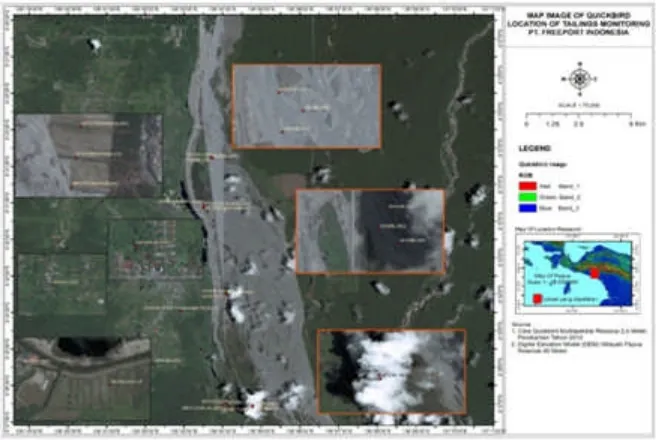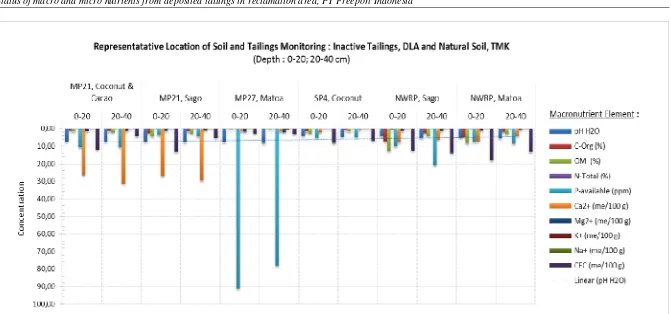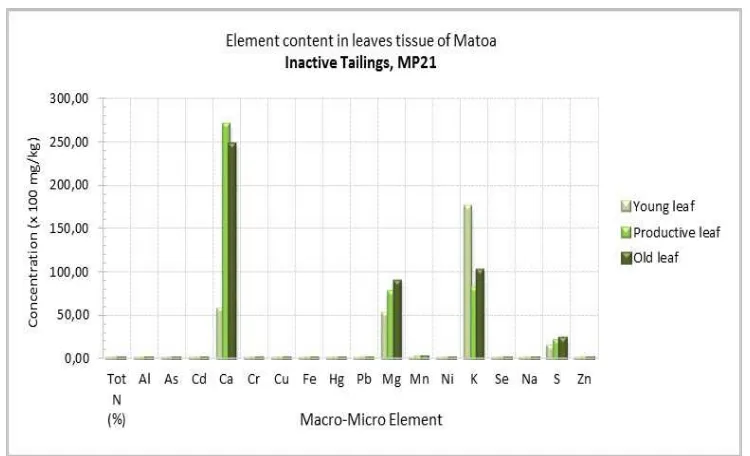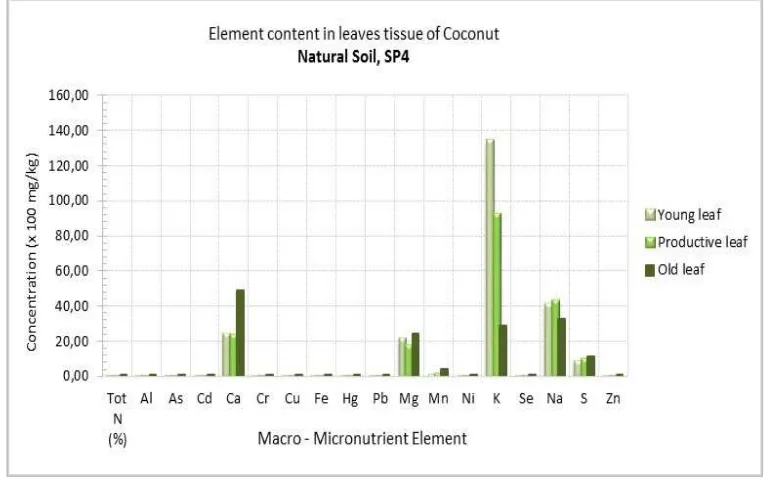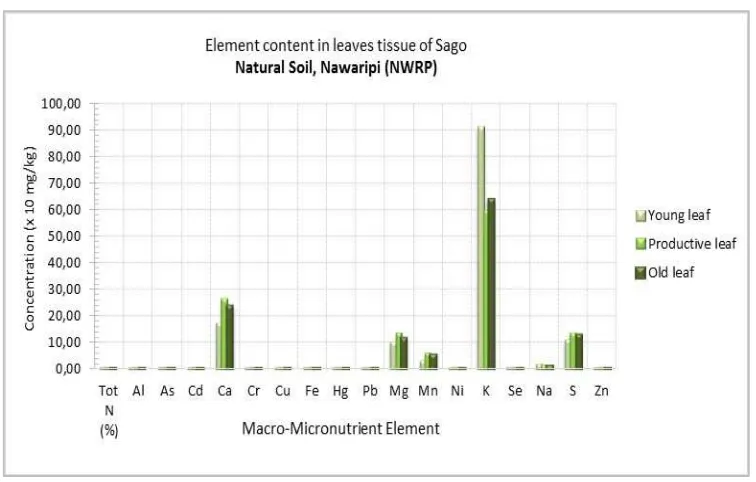ISSN: 2339-076X (e); 2502-2458 (p)
,
Volume 3, Number 3 (April 2016): 565-576
DOI:10.15243/jdmlm.2016.033.565
Research Article
Status of macro and micro nutrients from deposited tailings in
reclamation area, PT Freeport Indonesia, Timika
S. Taberima
1*, R. Sarwom
2 1Department of Soil Science, Faculty of Agriculture- University of Papua, Manokwari 98314 West Papua, Indonesia
2
Reclamation Division, Department of Environmental- PT Freeport Indonesia, Timika 99910 Papua, Indonesia * corresponding author: [email protected]
Abstract:
The reclamation program of deposited tailings (SIRSAT) is the obligation of the mining concession holder PT Freeport Indonesia (PTFI). The monitoring of soil and plant qualities regularly is part of the study of the success or performance of mining reclamation. The objective of research in the reclamation area was to study the uptake of macro and micronutrients in inactive tailings, and representative plants that grow up on it. The result showed that pH was alkaline in the land of MP21 with its plants ofM. sagoandC.nucifera, MP27 with Matoa (P.pinnata), both of the representative locations with tailings/soil depth of 0-20 cm and 20-40 cm, except the surface layer of MP21 has lower pH, i.e. neutral. The organic matter tends to be higher at MP21 withM. sago, followed byC. nucifera, while at MP27 with P. pinnata was very low on the surface layer (topsoil) and the bottom layer. MP27 was reclaimed in 2003 with P. pinnata, however these plants tend to be abnormal after being planted more than 10 years. While MP21 withM. sagoandC. nuciferawas more fertile due to high content of organic matter. Besides that, the tailings deposition at MP21 had became inactive tailings for longer, and were used for the land reclamation activities since 1992/1993. The uptake of macronutrients, especially K was high, which was found in both productive and old leaves in the representative plants of inactive tailings and natural soil. While the old leaves ofP. pinnataproduced the highest content of S, i.e. > 0,1%. Mnwas the highest in both of old leaves ofC. nucifera(379,50ppm) andM. Sago(558 ppm) which were planted in the natural soil. These concentration levels were higher than normal criteria (> 300 ppm Mn). The uptake of Zn includes normal criteria, except in the productive leaves (170,67ppm), and also the old leaves (160.33 ppm), or exceeds of the normal criteria (> 100 ppm Zn) found inP. pinnataMP21.Keywords:edible plant, plant tissue, reclamation, tailings
Introduction
The Reclamation program in tailings (SIRSAT : sand tailings) is the obligation of the holder of the mining concessions of PT Freeport Indonesia (PTFI). Impact of the operation of copper and gold mining at Grasberg, PTFI has made reclaimed tailings at DLA (Double Levee Area) -Timika. There are inactive tailings at DLA region, it is about 10-20 years old as inactive tailings, with an area of approximately 1500 hectares which has functioned as Natural Succession and Reclamation Areas. Succession area has a depth of shallow ground water and is wet, so easily it was covered by Phragmites karka as a pioneer, while the Reclamation Area has a depth of ground
Status of macro and micro nutrients from deposited tailings in reclamation area, PT Freeport Indonesia
Journal of Degraded and Mining Lands Management 566 of tailings deposition is needed, as futher study of
the success or performance of reclamation of the former mining area. The objective of research in the Land Reclamation was to study macro and micronutrients in inactive tailings, and its representative plants, and compared withnatural soil.
Materials and Methods
The research was conducted in the reclamation areas of MP21 and MP27 where the particle size of tailings were medium and fine, and non tailings as comparator of natural soil in Timika.Map of location is presented in Figure 1. The first research was conducted in 2011. The paper shows the observation data was in November 2013/2014 from the reclamation areas of MP 21 and MP27, and agricultural land of local people (SP4 and NWRP) in Timika.Sampling of tailings/soil were taken at two depths of 0-20 cm and 20-40 cm from land reclaimed with agricultural plants.Sampling of plant tissue (leaf) was taken from the shoots, middle, and bottom of the
canopy, with consideration that the translocation of macro and micro nutrients are accumulated in the leaf tissue of plants. The study of the uptake of macro and micro nutrients was conducted by the analysis of samples at the Laboratory. The chemical properties include of pH, C, N, P, S, Al, base cations (Ca, Mg, K, Na), CEC, Hg, Cd, Fe, Mn, Cu, and Zn. The physical properties, i.e. texture (particle size). The nutrient uptake of plant tissue, i.e. C, N, P, S, Al, Ca, Mg, K, Na, Hg, Cd, Fe, Mn, Cu, and Zn. The analysis of soil fertility was conducted at the Laboratory of SEAMEO -BIOTROP, Bogor. Fertility status of inactive tailings and natural soil of Timika is presented in Table 1. The analysis of uptake metal was at Timika Environment Laboratory (TEL), Timika. The data analysis was conducted statistically by mean value with tabulation. The criteria of chemical properties referred to Balai Penelitian Tanah (2005), the criteria of metal from tailings/soil and plant tissue referred to the Handbook of Trace Elements (Pais and Jones, 1997; see Tables 2 and 3).
Figure 1. The representative location in Reclamation Area and Natural Soil, Timika
Results and Discussion
Status of nutrient content in incative tailings and natural soil
Tailings have characteristics of chemical difference when compared with natural soil, which was derived from the parent rock, that contains minerals group of sulphides, such as
Table 1. Fertility status of inactive tailings and natural soil - Timika
Representative Depth pH Organic-C OM Total N Available P Ca2+ Mg2+ K+ Na+ CEC
Location (cm) (H2O) (%) (%) (%) (ppm) me/ 100 g
Inactive Tailings
MP21 0 - 20 7.53 2.59 4.46 0.07 3.63 26.92 1.29 0.27 0.32 13.21
20 - 40 7.70 1.65 2.85 0.05 4.33 29.44 1.06 0.27 0.30 5.31
MP27 0 - 20 7.73 0.36 0.62 0.02 91.17 1.25 1.81 0.35 0.30 2.79
20 - 40 8.40 0.27 0.47 0.03 78.27 1.48 2.15 0.44 0.41 3.07
Natural Soil
SP4 0 - 20 4.13 1.68 2.89 0.15 5.20 2.00 0.34 0.15 0.20 8.35
20 - 40 4.73 0.93 1.60 0.12 5.07 0.80 0.17 0.12 0.17 7.12
NWRP 0 - 20 4.43 7.36 12.69 0.48 10.07 7.71 1.27 0.14 0.31 12.58
20 - 40 5.37 2.49 4.30 0.29 20.63 6.26 1.38 0.16 0.27 14.04
Source : Analysis data was released by Soil Laboratory, SEAMEO - BIOTROP, Bogor (2014)
Status of macro and micro nutrients from deposited tail
Journal of Degraded and Mining Lands Management
Figure 2. Status o
tailings in reclamation area, PT Freeport Indonesia
ement
of Macronutrient Elements in the Land of Inactive TailingsandNatural Soil
To combat acidification due to the oxidation of sulfide mineral, tailings before they enter DLA have been limed at a neutralizing capacity at 1.5 times maximum potential acidity (PTFI, 2007). The material of CaO and CaCO3 that keeps tailings in the pH ranged 7-8. The results of the chemical parameter to the tailings/soil fertility showed that the value of pH was slightly alkaline in inactive tailings of MP21 and MP 27, whereas natural soil of SP4 and NWRP (non tailings) was very acid and acid. The value of pH in natural soil in topsoil (0 - 20 cm) was lower than subsoil (20-40 cm). These phenomenon were different from inactive tailings, the value of pH tends to increase with increasing soil depth. The condition can occur because of the increasing of Ca2+ in subsoil 20-40 cm of inactive tailings of MP21 and MP27. The addition of lime material into the soil, will lead the reactions with soil colloids, in this case the colloid of tailings which was derived from organic materials. Soil colloids will obstruct the reactions equilibrium to absorb Ca2+, so that the percentage of base saturation in the adsorption complex was higher. This condition causes the pH in the soil solution tend to increase. Therefore, organic C content decreased in subsoil with the increase of pH, especially on inactive tailings of MP21 and MP27.
The organic C content was high with the increasing CEC, particularly on the topsoil. The availability Ca content was the highest at MP21, i.e 26,92 me/100 g (0-20 cm) and 27,44 me/100 g (20-40 cm), followed bynontailing NWRP (7,71 me/100 g; 6,26 me/100 g), whereas MP 27 and SP4 had the availabiliy of Ca was low - very low. The natural phenomenon was found in natural soil also was seen in the inactive tailings area. Data showed that base cations of Ca were the highest, followed by Mg, Na, and K. These indicate that tailings material can be used as media of plant growth. However, it needs attention to the metal uptake in plant tissue. In consequence, planting of agricultural plants in the tailings needs organic matter as a chelating agent of the specific metals, so that is not absorbed by the plants directly, in excessive amounts.
Micro nutrients (heavy metal) in inactive tailingsandnatural soil
Tailings or natural soils have a limited buffer capacity to the heavy metals. This characteristicis determined by several factors such as pH, organic matter content, and CEC (cation exchange capacity) (Lepp, 1981). The presence of organic materials in the soil, besides being utilized by microorganisms as a source of energy, can react
with the heavy metals to form the organ metallic complex, to reduce the toxicity of heavy metals (Stevenson, 1982). Figure 3a-b, and 4 showed the total of Al, Fe, K was high enough on the tailings and natural soil, except Ca was found higher in the tailings (MP 21, MP27), because of the additional process with lime materials by the flotation technique of precious minerals and before tailings enter the lowlands, where they are deposited in the deposition area of DLA. Similarly, the total S was relatively higher in the tailings than natural soil and was very low due to the parent material of Grasberg which contains the group of sulphide minerals (PTFI, 1998).
Macro and micronutrients of the plant leaf tissue in incative tailings and natural soil
Status of macro and micro nutrients from deposited tailings in reclamation area, PT Freeport Indonesia
Journal of Degraded and Mining Lands Management 570
Status of macro and micro nutrients from deposited tailings in reclamation area, PT Freeport Indonesia
Journal of Degraded and Mining Lands Management 572
Figure 5. Status of nutrient content in leaf tissue of Matoa, inactive tailings of MP21
Figure 6. Status of nutrient content in leaf tissue of Matoa, inactive tailings of MP27
Figure 7-9 illustrates the general phenomenon of plants with higher K uptake, It tends to cause an antagonism among other macro nutrients. Potassium (K) excess causes the absorption of Ca and Mg were inhibited, and also plant growth, so the plants became deficient of these nutrients (Havlin et al., 2005). Nevertheless K was needed by plants to improve its resistance to disease plus formation and strengthening of generative organs.
followed by Sago (NWRP) with concentration more than 0,1% S. Generally total S in the soil ranged from 30 to 1000 ppm with the approximation of mean value is 700 ppm (0,07%) (Lindsay, 1979).Tabatabai et al. (1988) stated thattotal of S in the natural soil ranged from < 20 ppm on sandy soil until> 600 ppm on soil textured solid, while most of soil contains S between 100 and 500 ppm. At the Double Leeve Area (DLA),
total S is relatively high because parent material from Grasberg contains the group of sulphide minerals. MacDonald and Arnold (1994) reported that total S content in the parent material of Grasberg mined, was 1,59 %. Related to the plant need, S is an essential element in the formation of various types of amino acid and leaf green (chlorophyll), as well as Fe, Mn, Zn, and Mg butin less concentrations.
Figure 7. Nutrient content in leaf tissue of Coconut, inactive tailings of MP21
Status of macro and micro nutrients from deposited tailings in reclamation area, PT Freeport Indonesia
Journal of Degraded and Mining Lands Management 574
Figure 9. Nutrient content in leaf tissue of Sago, natural soil of NWRP
Base on data of the absorption of micro nutrients which is tolerable by plants (Pais dan Jones, 1991) that Fe contained in plant leaves of matoa, coconut, and sago which growing up on inactive tailings and natural soils are categorized as sufficient and normal with ranges less than 100 ppm, while Mn is the highest in old leaves of coconut (379,50 ppm) and sago (558 ppm) which growing up on natural soil and exceed of normal criteria (> 300 ppm Mn). At the same time Cu uptake includes normal category, i.e. 4-20 ppm in young, productive, and old leavesas the representative plants that growing up in the inactive tailings or natural soil. Reuther and Labanauskas (1975) reported that Cu is protected in most soils with values of pH ranged 7-8, and inadequately protected with pH of neutral to acid.
It was reported that liming to the soil up to pH 6 tends to reduce the toxicity of Cu, includes Fe, Mn, and Zn. The uptake of Zn includes normal category, except in leaf tissue of matoa MP21 was found the absorption of Zn exceed of normal criteria, i.e more than 100 ppm Zn. It was found in productive and old leaves, i.e 170,67 ppm and 160,33 ppm respectively. There is a tendency of micro-nutrient uptake in the plant tissue, i.e when Zn uptake is high that the uptake of Cu tends to decrease as well as between Fe and Mn. This phenomenon may occur due to the micro element has oxidation numberof two divalent cation (+2) with the same size, that there is a competition among nutrients uptake from the soil solution towards the plant tissue.
Tabel 2. Approximate concentration of the micronutrients in mature leaf tissue generalized for various plant species
Micronutrients Deficient Sufficient or Normal Excessive or Toxic mg/kg (ppm)
Boron (B) 5 - 30 10 - 200 50 - 200
Chlorine (Cl) < 100 100 - 500 500 - 1000
Copper (Cu) 2 - 5 5 - 30 20 - 100
Iron (Fe) < 50 100 - 500 > 500
Manganese (Mn) 15 - 25 20 - 300 300 - 500
Molybdenum (Mo) 0.03 - 0.15 - 2.0 > 100
Zinc (Zn) 1 - 20 27 - 100 100 - 400
Tabel 3.Amount of various trace elements tolerable to plants
Element Range (mk/kg) Common Level (mg/kg) Amount Tolerable (Proposed)
Arsenic (As) 1.0 - 5.0 2.0 - 20 50
Remarks :The Handbook of Trace Elements, page 50 (Pais and Jones, 1997)
Based on the observation of several agricultural plants as the representatives that are growing up in Reclamation Area, the result data of monitoring activity is to study the impact of macro and micronutrients uptake by plants or natural soil/tailings. Therefore there is not recommendation yet can be issued at the moment, because the research is still ongoing with further tests of edible plant for several months period to study the metals uptake as well as macro and micro nutrients in tailings media and natural soil as comparator (non tailings).
Conclusion
The organic matter tends to be higher at MP21 with sago, followed by coconut at the same area of inactive tailings, while at MP27 with matoawas very low in concentration on the surface layer and the bottom layer.
MP27 has been reclaimed since 2003 with matoa, however its growth tend to be abnormal after being planted more than 10 years. While MP21 with sago and coconut were more fertile due to high content of organic matter. Besides that, the tailings deposition had became inactive tailings for longer, and were used for the land reclamation activities since 1992/1993.
Macro nutrient uptake, especially potassium (K) was quite high in the productive and old leaves of plants that grownat the inactive tailings and natural soil. The uptake of S was the highest in the leaves tissue of matoa at MP21, followed by sago at NWRP with concentration of Mn uptake was > 0.1%. The uptake of Mn was the highest in the old leaves of coconut (379.50 ppm), and sago (558 ppm) from natural soil, which
concentration of Mn has exceeded of normal criteria (> 300 ppm Mn). The uptake of Zn was categorized as normal, except in the productive leaves (170.67 ppm), and the old leaves (160.33 ppm) were exceeds of normal criteria (> 100 ppm Zn) which found at MP21 with matoa.
Acknowledgments
The research was supported by Environmental Department of PT Freeport Indonesia, especially Division of Reclamation and Biodiversity MP 21, Timika. The authors would like to thank to the University of Papua (UNIPA) as a cooperation partner of PT Freeport Indonesia for its support, as well as the Dean of the Faculty of Agriculture, and researchers of Soil Department - Faculty of Agriculture UNIPA who has given permission and support the research.
References
Balai Penelitian Tanah. 2005. Analisis Kimia Tanah, Tanaman, Air dan Pupuk. Badan Penelitian dan Pengembangan Pertanian, Departemen Pertanian. Bogor.
Biddulph, O. 1953. Translocation of radioactive mineral nutrients in plants. In: The Use of Isotopes in Plant and Animal Research, Report No. 4, Agr. Expt. Sta., Kansas State College, Manhattan, or U.S.A.E.C., Wash. D.C. TID 5098. April 1953. Havlin, J. L., Beaton, J.C., Tisdale, S.L. and Nelson,
W.L. 2005. Soil Fertility and Fertilizers. An Introduction to Nutrient Management. Sixth Edition. Pearson Prentice Hall, Upper Saddle River, New Jersey. 515p.
Status of macro and micro nutrients from deposited tailings in reclamation area, PT Freeport Indonesia
Journal of Degraded and Mining Lands Management 576
Lehmann, J. and Schroth, G., 2003. Nutrient Leaching. © CAB International 2003. Trees, Crops and Soil Fertility (eds G. Schroth and F. L. Sinclair). Lepp, N.W. 1981. Effect of Heavy Metal Pollution on
Plant. Volume I. Effect of Trace Metan on Plant Function. Applied Science Publishers, London. Lindsay, W. L. 1979. Chemical Equilibria in Soils. A
Wiley Interscience Publication. John Wiley & Sons, New York - Chichester - Brisbane - Toronto. MacDonald, G.D. and Arnold, L.C. 1994. Geological
and geochemical zoning of the Grasberg Igneous Complex, Irian Jaya. Journal of Geochemical Exploration50: 143-144.
PTFI. 1998.Rencana Tahunan Lima Tahun Pertama (1999-2003). Reklamasi Daerah Pengendapan Tailing. PT Freeport Indonesia.
PTFI. 2007. Laporan Pelaksanaan Pengelolaan dan Pemantauan Lingkungan. Triwulan 1 Tahun 2007. PT Freeport Indonesia. Jakarta.
Reuther, W. and Labanauskas, C. K. 1975. Copper.In
Diagnostic Criteria For Plants and Soils. Edited by Homer D. Chapman. Dept. of Soil and Plant Nutrition, Univ. of California. Eurasia Publishing House (P) LTD. Ram Nagar, New Dehli.
Stevenson, F.J. 1982. Humus Chemistry : Genesis, Composition, Raction. John Willey, New York. Tabatai, M. A., Basta, N.T. and Pirela, H.J. 1988.
Determination of total sulfur in soil dan plant materials by ion chromatograpy.Communication in Soil Science and Plant Analysis19:1701-1714. Taberima, S., Mulyanto, B., Sudarsono, Sumawinata,
